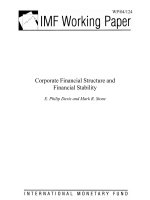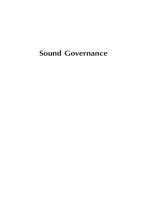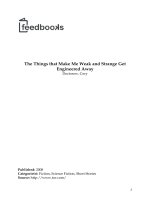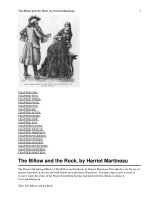PROBABILITY AND MATHEMATICAL STATISTICS pptx
Bạn đang xem bản rút gọn của tài liệu. Xem và tải ngay bản đầy đủ của tài liệu tại đây (4.12 MB, 703 trang )
PROBABILITY
AND
MATHEMATICAL STATISTICS
Prasanna Sahoo
Department of Mathematics
University of Louisville
Louisville, KY 40292 USA
v
THIS BOOK IS DEDICATED TO
AMIT
SADHNA
MY PARENTS, TEACHERS
AND
STUDENTS
vi
vii
Copyright
c
2008. All rights reserved. This book, or parts thereof, may
not be reproduced in any form or by any means, electronic or mechanical,
including photocopying, recording or any information storage and retrieval
system now known or to be invented, without written permission from the
author.
viii
ix
PREFACE
This book is both a tutorial and a textbook. This book presents an introduc-
tion to probability and mathematical statistics and it is intended for students
already having some elementary mathematical background. It is intended for
a one-year junior or senior level undergraduate or beginning graduate level
course in probability theory and mathematical statistics. The book contains
more material than normally would be taught in a one-year course. This
should give the teacher flexibility with respect to the selection of the content
and level at which the book is to be used. This book is based on over 15
years of lectures in senior level calculus based courses in probability theory
and mathematical statistics at the University of Louisville.
Probability theory and mathematical statistics are difficult subjects both
for students to comprehend and teachers to explain. Despite the publication
of a great many textbooks in this field, each one intended to provide an im-
provement over the previous textbooks, this subject is still difficult to com-
prehend. A good set of examples makes these subjects easy to understand.
For this reason alone I have included more than 350 completely worked out
examples and over 165 illustrations. I give a rigorous treatment of the fun-
damentals of probability and statistics using mostly calculus. I have given
great attention to the clarity of the presentation of the materials. In the
text, theoretical results are presented as theorems, propositions or lemmas,
of which as a rule rigorous proofs are given. For the few exceptions to this
rule references are given to indicate where details can be found. This book
contains over 450 problems of varying degrees of difficulty to help students
master their problem solving skill.
In many existing textbooks, the examples following the explanation of
a topic are too few in numb er or too simple to obtain a through grasp of
the principles involved. Often, in many books, examples are presented in
abbreviated form that leaves out much material between steps, and requires
that students derive the omitted materials themselves. As a result, students
find examples difficult to understand. Moreover, in some textbooks, examples
x
are often worded in a confusing manner. They do not state the problem and
then present the solution. Instead, they pass through a general discussion,
never revealing what is to be solved for. In this book, I give many examples
to illustrate each topic. Often we provide illustrations to promote a better
understanding of the topic. All examples in this book are formulated as
questions and clear and concise answers are provided in step-by-step detail.
There are several good books on these subjects and perhaps there is
no need to bring a new one to the market. So for several years, this was
circulated as a series of typeset lecture notes among my students who were
preparing for the examination 110 of the Actuarial Society of America. Many
of my students encouraged me to formally write it as a book. Actuarial
students will benefit greatly from this book. The book is written in simple
English; this might be an advantage to students whose native language is not
English.
I cannot claim that all the materials I have written in this book are mine.
I have learned the subject from many excellent books, such as Introduction
to Mathematical Statistics by Hogg and Craig, and An Introduction to Prob-
ability Theory and Its Applications by Feller. In fact, these books have had
a profound impact on me, and my explanations are influenced greatly by
these textb ooks. If there are some similarities, then it is due to the fact
that I could not make improvements on the original explanations. I am very
thankful to the authors of these great textbooks. I am also thankful to the
Actuarial Society of America for letting me use their test problems. I thank
all my students in my probability theory and mathematical statistics courses
from 1988 to 2005 who helped me in many ways to make this book possible
in the present form. Lastly, if it weren’t for the infinite patience of my wife,
Sadhna, this book would never get out of the hard drive of my computer.
The author on a Macintosh computer using T
E
X, the typesetting system
designed by Donald Knuth, typeset the entire book. The figures were gener-
ated by the author using MATHEMATICA, a system for doing mathematics
designed by Wolfram Research, and MAPLE, a system for doing mathemat-
ics designed by Maplesoft. The author is very thankful to the University of
Louisville for providing many internal financial grants while this book was
under preparation.
Prasanna Sahoo, Louisville
xi
xii
TABLE OF CONTENTS
1. Probability of Events . . . . . . . . . . . . . . . . . . . 1
1.1. Introduction
1.2. Counting Techniques
1.3. Probability Measure
1.4. Some Properties of the Probability Measure
1.5. Review Exercises
2. Conditional Probability and Bayes’ Theorem . . . . . . . 27
2.1. Conditional Probability
2.2. Bayes’ Theorem
2.3. Review Exercises
3. Random Variables and Distribution Functions . . . . . . . 45
3.1. Introduction
3.2. Distribution Functions of Discrete Variables
3.3. Distribution Functions of Continuous Variables
3.4. Percentile for Continuous Random Variables
3.5. Review Exercises
4. Moments of Random Variables and Chebychev Inequality . 73
4.1. Moments of Random Variables
4.2. Expected Value of Random Variables
4.3. Variance of Random Variables
4.4. Chebychev Inequality
4.5. Moment Generating Functions
4.6. Review Exercises
xiii
5. Some Special Discrete Distributions . . . . . . . . . . . 107
5.1. Bernoulli Distribution
5.2. Binomial Distribution
5.3. Geometric Distribution
5.4. Negative Binomial Distribution
5.5. Hypergeometric Distribution
5.6. Poisson Distribution
5.7. Riemann Zeta Distribution
5.8. Review Exercises
6. Some Special Continuous Distributions . . . . . . . . . 141
6.1. Uniform Distribution
6.2. Gamma Distribution
6.3. Beta Distribution
6.4. Normal Distribution
6.5. Lognormal Distribution
6.6. Inverse Gaussian Distribution
6.7. Logistic Distribution
6.8. Review Exercises
7. Two Random Variables . . . . . . . . . . . . . . . . . 185
7.1. Bivariate Discrete Random Variables
7.2. Bivariate Continuous Random Variables
7.3. Conditional Distributions
7.4. Independence of Random Variables
7.5. Review Exercises
8. Product Moments of Bivariate Random Variables . . . . 213
8.1. Covariance of Bivariate Random Variables
8.2. Independence of Random Variables
8.3. Variance of the Linear Combination of Random Variables
8.4. Correlation and Independence
8.5. Moment Generating Functions
8.6. Review Exercises
xiv
9. Conditional Expectations of Bivariate Random Variables 237
9.1. Conditional Expected Values
9.2. Conditional Variance
9.3. Regression Curve and Scedastic Curves
9.4. Review Exercises
10. Functions of Random Variables and Their Distribution . 257
10.1. Distribution Function Method
10.2. Transformation Method for Univariate Case
10.3. Transformation Method for Bivariate Case
10.4. Convolution Method for Sums of Random Variables
10.5. Moment Method for Sums of Random Variables
10.6. Review Exercises
11. Some Special Discrete Bivariate Distributions . . . . . 289
11.1. Bivariate Bernoulli Distribution
11.2. Bivariate Binomial Distribution
11.3. Bivariate Geometric Distribution
11.4. Bivariate Negative Binomial Distribution
11.5. Bivariate Hypergeometric Distribution
11.6. Bivariate Poisson Distribution
11.7. Review Exercises
12. Some Special Continuous Bivariate Distributions . . . . 317
12.1. Bivariate Uniform Distribution
12.2. Bivariate Cauchy Distribution
12.3. Bivariate Gamma Distribution
12.4. Bivariate Beta Distribution
12.5. Bivariate Normal Distribution
12.6. Bivariate Logistic Distribution
12.7. Review Exercises
xv
13. Sequences of Random Variables and Order Statistics . . 351
13.1. Distribution of Sample Mean and Variance
13.2. Laws of Large Numbers
13.3. The Central Limit Theorem
13.4. Order Statistics
13.5. Sample Percentiles
13.6. Review Exercises
14. Sampling Distributions Associated with
the Normal Population . . . . . . . . . . . . . . . . . 391
14.1. Chi-square distribution
14.2. Student’s t-distribution
14.3. Snedecor’s F-distribution
14.4. Review Exercises
15. Some Techniques for Finding Point
Estimators of Parameters . . . . . . . . . . . . . . . 409
15.1. Moment Method
15.2. Maximum Likelihood Method
15.3. Bayesian Method
15.3. Review Exercises
16. Criteria for Evaluating the Goodness
of Estimators . . . . . . . . . . . . . . . . . . . . . 449
16.1. The Unbiased Estimator
16.2. The Relatively Efficient Estimator
16.3. The Minimum Variance Unbiased Estimator
16.4. Sufficient Estimator
16.5. Consistent Estimator
16.6. Review Exercises
xvi
17. Some Techniques for Finding Interval
Estimators of Parameters . . . . . . . . . . . . . . . 489
17.1. Interval Estimators and Confidence Intervals for Parameters
17.2. Pivotal Quantity Method
17.3. Confidence Interval for Population Mean
17.4. Confidence Interval for Population Variance
17.5. Confidence Interval for Parameter of some Distributions
not belonging to the Location-Scale Family
17.6. Approximate Confidence Interval for Parameter with MLE
17.7. The Statistical or General Method
17.8. Criteria for Evaluating Confidence Intervals
17.9. Review Exercises
18. Test of Statistical Hypotheses . . . . . . . . . . . . . 533
18.1. Introduction
18.2. A Method of Finding Tests
18.3. Methods of Evaluating Tests
18.4. Some Examples of Likelihood Ratio Tests
18.5. Review Exercises
19. Simple Linear Regression and Correlation Analysis . . 577
19.1. Least Squared Method
19.2. Normal Regression Analysis
19.3. The Correlation Analysis
19.4. Review Exercises
20. Analysis of Variance . . . . . . . . . . . . . . . . . . 613
20.1. One-way Analysis of Variance with Equal Sample Sizes
20.2. One-way Analysis of Variance with Unequal Sample Sizes
20.3. Pair wise Comparisons
20.4. Tests for the Homogeneity of Variances
20.5. Review Exercises
xvii
21. Goodness of Fits Tests . . . . . . . . . . . . . . . . . 645
21.1. Chi-Squared test
21.2. Kolmogorov-Smirnov test
21.3. Review Exercises
References . . . . . . . . . . . . . . . . . . . . . . . . . 663
Answers to Selected Review Exercises . . . . . . . . . . . 669
Probability and Mathematical Statistics 1
Chapter 1
PROBABILITY OF EVENTS
1.1. Introduction
During his lecture in 1929, Bertrand Russel said, “Probability is the most
important concept in modern science, especially as nobody has the slightest
notion what it means.” Most people have some vague ideas about what prob-
ability of an event means. The interpretation of the word probability involves
synonyms such as chance, odds, uncertainty, prevalence, risk, expectancy etc.
“We use probability when we want to make an affirmation, but are not quite
sure,” writes J.R. Lucas.
There are many distinct interpretations of the word probability. A com-
plete discussion of these interpretations will take us to areas such as phi-
losophy, theory of algorithm and randomness, religion, etc. Thus, we will
only focus on two extreme interpretations. One interpretation is due to the
so-called objective school and the other is due to the subjective school.
The subjective school defines probabilities as subjective assignments
based on rational thought with available information. Some subjective prob-
abilists interpret probabilities as the degree of belief. Thus, it is difficult to
interpret the probability of an event.
The objective school defines probabilities to be “long run” relative fre-
quencies. This means that one should compute a probability by taking the
number of favorable outcomes of an exp eriment and dividing it by total num-
bers of the possible outcomes of the experiment, and then taking the limit
as the number of trials becomes large. Some statisticians object to the word
“long run”. The philosopher and statistician John Keynes said “in the long
run we are all dead”. The objective school uses the theory developed by
Probability of Events 2
Von Mises (1928) and Kolmogorov (1965). The Russian mathematician Kol-
mogorov gave the solid foundation of probability theory using measure theory.
The advantage of Kolmogorov’s theory is that one can construct probabilities
according to the rules, compute other probabilities using axioms, and then
interpret these probabilities.
In this book, we will study mathematically one interpretation of prob-
ability out of many. In fact, we will study probability theory based on the
theory developed by the late Kolmogorov. There are many applications of
probability theory. We are studying probability theory because we would
like to study mathematical statistics. Statistics is concerned with the de-
velopment of methods and their applications for collecting, analyzing and
interpreting quantitative data in such a way that the reliability of a con-
clusion based on data may be evaluated objectively by means of probability
statements. Probability theory is used to evaluate the reliability of conclu-
sions and inferences based on data. Thus, probability theory is fundamental
to mathematical statistics.
For an event A of a discrete sample space S, the probability of A can be
computed by using the formula
P (A) =
N(A)
N(S)
where N(A) denotes the number of elements of A and N(S) denotes the
number of elements in the sample space S. For a discrete case, the probability
of an event A can be computed by counting the number of elements in A and
dividing it by the number of elements in the sample space S.
In the next section, we develop various counting techniques. The branch
of mathematics that deals with the various counting techniques is called
combinatorics.
1.2. Counting Techniques
There are three basic counting techniques. They are multiplication rule,
permutation and combination.
1.2.1 Multiplication Rule. If E
1
is an experiment with n
1
outcomes
and E
2
is an experiment with n
2
possible outcomes, then the experiment
which consists of performing E
1
first and then E
2
consists of n
1
n
2
possible
outcomes.
H
T
H
T
H
T
HH
HT
TH
TT
Tree diagram
Tree diagram
1
2
3
4
5
6
1H
1T
2H
2T
3H
3T
4H
4T
5H
5T
6H
6T
H
T
Probability and Mathematical Statistics 3
Example 1.1. Find the p ossible number of outcomes in a sequence of two
tosses of a fair coin.
Answer: The number of possible outcomes is 2 ·2 = 4. This is evident from
the following tree diagram.
Example 1.2. Find the number of possible outcomes of the rolling of a die
and then tossing a coin.
Answer: Here n
1
= 6 and n
2
= 2. Thus by multiplication rule, the number
of possible outcomes is 12.
Example 1.3. How many different license plates are possible if Kentucky
uses three letters followed by three digits.
Answer:
(26)
3
(10)
3
= (17576) (1000)
= 17, 576, 000.
1.2.2. Permutation
Consider a set of 4 objects. Suppose we want to fill 3 positions with
objects selected from the above 4. Then the numb er of possible ordered
arrangements is 24 and they are
Probability of Events 4
a b c b a c c a b d a b
a b d b a d c a d d a c
a c b b c a c b a d b c
a c d b c d c b d d b a
a d c b d a c d b d c a
a d b b d c c d a d c b
The number of possible ordered arrangements can be computed as follows:
Since there are 3 positions and 4 objects, the first position can be filled in
4 different ways. Once the first position is filled the remaining 2 positions
can be filled from the remaining 3 objects. Thus, the second position can be
filled in 3 ways. The third position can be filled in 2 ways. Then the total
number of ways 3 positions can be filled out of 4 objects is given by
(4) (3) (2) = 24.
In general, if r positions are to be filled from n objects, then the total
number of possible ways they can be filled are given by
n(n − 1)(n − 2) ···(n − r + 1)
=
n!
(n − r)!
=
n
P
r
.
Thus,
n
P
r
represents the number of ways r positions can be filled from n
objects.
Definition 1.1. Each of the
n
P
r
arrangements is called a permutation of n
objects taken r at a time.
Example 1.4. How many permutations are there of all three of letters a, b,
and c?
Answer:
3
P
3
=
n!
(n − r)!
=
3!
0!
= 6
.
Probability and Mathematical Statistics 5
Example 1.5. Find the number of permutations of n distinct objects.
Answer:
n
P
n
=
n!
(n − n)!
=
n!
0!
= n!.
Example 1.6. Four names are drawn from the 24 members of a club for the
offices of President, Vice-President, Treasurer, and Secretary. In how many
different ways can this be done?
Answer:
24
P
4
=
(24)!
(20)!
= (24) (23) (22) (21)
= 255, 024.
1.2.3. Combination
In permutation, order is important. But in many problems the order of
selection is not important and interest centers only on the set of r objects.
Let c denote the number of subsets of size r that can be selected from
n different objects. The r objects in each set can be ordered in
r
P
r
ways.
Thus we have
n
P
r
= c (
r
P
r
) .
From this, we get
c =
n
P
r
r
P
r
=
n!
(n − r)! r!
The number c is denoted by
n
r
. Thus, the above can be written as
n
r
=
n!
(n − r)! r!
.
Definition 1.2. Each of the
n
r
unordered subsets is called a combination
of n objects taken r at a time.
Example 1.7. How many committees of two chemists and one physicist can
be formed from 4 chemists and 3 physicists?
Probability of Events 6
Answer:
4
2
3
1
= (6) (3)
= 18.
Thus 18 different committees can be formed.
1.2.4. Binomial Theorem
We know from lower level mathematics courses that
(x + y)
2
= x
2
+ 2 xy + y
2
=
2
0
x
2
+
2
1
xy +
2
2
y
2
=
2
k=0
2
k
x
2−k
y
k
.
Similarly
(x + y)
3
= x
3
+ 3 x
2
y + 3xy
2
+ y
3
=
3
0
x
3
+
3
1
x
2
y +
3
2
xy
2
+
3
3
y
3
=
3
k=0
3
k
x
3−k
y
k
.
In general, using induction arguments, we can show that
(x + y)
n
=
n
k=0
n
k
x
n−k
y
k
.
This result is called the Binomial Theorem. The coefficient
n
k
is called the
binomial coefficient. A combinatorial proof of the Binomial Theorem follows.
If we write (x + y)
n
as the n times the product of the factor (x + y), that is
(x + y)
n
= (x + y) (x + y) (x + y) ···(x + y),
then the coefficient of x
n−k
y
k
is
n
k
, that is the number of ways in which we
can choose the k factors providing the y’s.
Probability and Mathematical Statistics 7
Remark 1.1. In 1665, Newton discovered the Binomial Series. The Binomial
Series is given by
(1 + y)
α
= 1 +
α
1
y +
α
2
y
2
+ ···+
α
n
y
n
+ ···
= 1 +
∞
k=1
α
k
y
k
,
where α is a real number and
α
k
=
α(α − 1)(α − 2) ···(α −k + 1)
k!
.
This
α
k
is called the generalized binomial coefficient.
Now, we investigate some properties of the binomial coefficients.
Theorem 1.1. Let n ∈ N (the set of natural numb ers) and r = 0, 1, 2, , n.
Then
n
r
=
n
n − r
.
Proof: By direct verification, we get
n
n − r
=
n!
(n − n + r)! (n −r)!
=
n!
r! (n − r)!
=
n
r
.
This theorem says that the binomial coefficients are symmetrical.
Example 1.8. Evaluate
3
1
+
3
2
+
3
0
.
Answer: Since the combinations of 3 things taken 1 at a time are 3, we get
3
1
= 3. Similarly,
3
0
is 1. By Theorem 1,
3
1
=
3
2
= 3.
Hence
3
1
+
3
2
+
3
0
= 3 + 3 + 1 = 7.
Probability of Events 8
Theorem 1.2. For any positive integer n and r = 1, 2, 3, , n, we have
n
r
=
n − 1
r
+
n − 1
r −1
.
Proof:
(1 + y)
n
= (1 + y) (1 + y)
n−1
= (1 + y)
n−1
+ y (1 + y)
n−1
n
r=0
n
r
y
r
=
n−1
r=0
n − 1
r
y
r
+ y
n−1
r=0
n − 1
r
y
r
=
n−1
r=0
n − 1
r
y
r
+
n−1
r=0
n − 1
r
y
r+1
.
Equating the coefficients of y
r
from both sides of the above expression, we
obtain
n
r
=
n − 1
r
+
n − 1
r −1
and the proof is now complete.
Example 1.9. Evaluate
23
10
+
23
9
+
24
11
.
Answer:
23
10
+
23
9
+
24
11
=
24
10
+
24
11
=
25
11
=
25!
(14)! (11)!
= 4, 457, 400.
Example 1.10. Use the Binomial Theorem to show that
n
r=0
(−1)
r
n
r
= 0.
Answer: Using the Binomial Theorem, we get
(1 + x)
n
=
n
r=0
n
r
x
r
Probability and Mathematical Statistics 9
for all real numbers x. Letting x = −1 in the above, we get
0 =
n
r=0
n
r
(−1)
r
.
Theorem 1.3. Let m and n be positive integers. Then
k
r=0
m
r
n
k −r
=
m + n
k
.
Proof:
(1 + y)
m+n
= (1 + y)
m
(1 + y)
n
m+n
r=0
m + n
r
y
r
=
m
r=0
m
r
y
r
n
r=0
n
r
y
r
.
Equating the coefficients of y
k
from the both sides of the above expression,
we obtain
m + n
k
=
m
0
n
k
+
m
1
n
k −1
+ ···+
m
k
n
k −k
and the conclusion of the theorem follows.
Example 1.11. Show that
n
r=0
n
r
2
=
2n
n
.
Answer: Let k = n and m = n. Then from Theorem 3, we get
k
r=0
m
r
n
k −r
=
m + n
k
n
r=0
n
r
n
n − r
=
2n
n
n
r=0
n
r
n
r
=
2n
n
n
r=0
n
r
2
=
2n
n
.
Probability of Events 10
Theorem 1.4. Let n be a positive integer and k = 1, 2, 3, , n. Then
n
k
=
n−1
m=k−1
m
k −1
.
Proof: In order to establish the above identity, we use the Binomial Theorem
together with the following result of the elementary algebra
x
n
− y
n
= (x − y)
n−1
k=0
x
k
y
n−1−k
.
Note that
n
k=1
n
k
x
k
=
n
k=0
n
k
x
k
− 1
= (x + 1)
n
− 1
n
by Binomial Theorem
= (x + 1 − 1)
n−1
m=0
(x + 1)
m
by above identity
= x
n−1
m=0
m
j=0
m
j
x
j
=
n−1
m=0
m
j=0
m
j
x
j+1
=
n
k=1
n−1
m=k−1
m
k −1
x
k
.
Hence equating the coefficient of x
k
, we obtain
n
k
=
n−1
m=k−1
m
k −1
.
This completes the proof of the theorem.
The following result
(x
1
+ x
2
+ ···+ x
m
)
n
=
n
1
+n
2
+···+n
m
=n
n
n
1
, n
2
, , n
m
x
n
1
1
x
n
2
2
···x
n
m
m
is known as the multinomial theorem and it generalizes the binomial theorem.
The sum is taken over all positive integers n
1
, n
2
, , n
m
such that n
1
+ n
2
+
···+ n
m
= n, and
n
n
1
, n
2
, , n
m
=
n!
n
1
! n
2
!, , n
m
!
.
Probability and Mathematical Statistics 11
This coefficient is known as the multinomial coefficient.
1.3. Probability Measure
A random experiment is an experiment whose outcomes cannot be pre-
dicted with certainty. However, in most cases the collection of every possible
outcome of a random experiment can be listed.
Definition 1.3. A sample space of a random experiment is the collection of
all possible outcomes.
Example 1.12. What is the sample space for an experiment in which we
select a rat at random from a cage and determine its sex?
Answer: The sample space of this experiment is
S = {M, F}
where M denotes the male rat and F denotes the female rat.
Example 1.13. What is the sample space for an experiment in which the
state of Kentucky picks a three digit integer at random for its daily lottery?
Answer: The sample space of this experiment is
S = {000, 001, 002, ······, 998, 999}.
Example 1.14. What is the sample space for an experiment in which we
roll a pair of dice, one red and one green?
Answer: The sample space S for this experiment is given by
S =
{(1, 1) (1, 2) (1, 3) (1, 4) (1, 5) (1, 6)
(2, 1) (2, 2) (2, 3) (2, 4) (2, 5) (2, 6)
(3, 1) (3, 2) (3, 3) (3, 4) (3, 5) (3, 6)
(4, 1) (4, 2) (4, 3) (4, 4) (4, 5) (4, 6)
(5, 1) (5, 2) (5, 3) (5, 4) (5, 5) (5, 6)
(6, 1) (6, 2) (6, 3) (6, 4) (6, 5) (6, 6)}
This set S can be written as
S = {(x, y) |1 ≤ x ≤ 6, 1 ≤ y ≤ 6}
where x represents the number rolled on red die and y denotes the number
rolled on green die.









